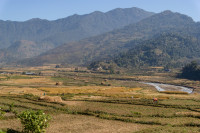Opinion
Lost in numbers
A wrong picture of migrant worker deaths has been given, as statistics were misread
Anil Bhattarai
Death is a difficult thing to face. It is a traumatic experience for those who lose their loved ones. Most humans are empathetic to other humans, and are moved by direct or indirect experiences of death. We have been reading that about three bodies of migrant workers arrive at Tribhuvan International Airport daily. According to the Ministry of Labour and Employment, 1,004 Nepali migrant workers died abroad in fiscal 2014-15. The harrowing experience of the family
members who receive the bodies is indeed moving. The depiction in news reports of these moving scenes and the suffering that families go through is important to highlight the plight of workers. If proper numbers are incorporated in these human interest stories, it can lend emotional valence and factual legitimacy to them.
However, numbers are tricky things. If we do not know what they mean, we might end up with wrong calculations. For example, a recent investigative report by the Associated Press and a research report by the International Labour Organisation (ILO) ended up producing wrong numbers.
Hint of collusion
The story by Martha Mendoza of the Associated Press zooms in on Saro Kumari Mandal, the wife of a dead migrant worker Balkisun Mandal Khatwe, as she grieves over his coffin. She goes home to the Tarai and navigates Nepal’s government offices to claim the compensation money. The reporter has highlighted the seemingly alarming rise in the death rate among migrant workers. She writes: “The number of Nepali workers going abroad has more than doubled since the country began promoting foreign labour in recent years: from about 220,000 in 2008 to about 500,000 in 2015. Yet the number of deaths among those workers has risen much faster in the same period. One out of every 2,500 workers died in 2008; last year one out of every 500 died, according to the data released by the Ministry of Labour and Employment.”
This is the same government statement on which a report produced by the ILO is based. The report entitled “When the Safety of Nepali Migrant Workers Fails” points out the problematic way ‘causes of death’ are classified in government reports, and even hints at a collusion between officials and employers in labelling death in a particular way to hide the actual working and living conditions. However, both reports have got the death rates wrong. The rates that result from the available statistics do not show that they are increasing over time. Nor do they show that they are higher than comparable death rates among similar population cohorts in Nepal. These two reports came up with wrong death rates because of a fundamental flaw in reading numbers.
In Nepal and many other countries, death rates are calculated for population cohorts at five-year intervals. In demography and public health, they are called age-specific death rates.
The ILO report shows that the death records kept by various agencies do not have age-specific data. Therefore, the age-specific rate could not be calculated for the migrant deaths. Because most migrant workers are able bodied and younger age cohorts, let’s assume the dead ones were in the 20-29 age group.
Here, the ILO report, which otherwise asks intelligent questions about the quality of the existing data, makes a major mistake in calculating the death rate. The report gives the death rates for each year between 2008-9 and 2014-15. However, it uses the annual flow of migrants to calculate the death rate for that year. That is a wrong method of calculation. These deaths occurred among the existing pool of migrant population in that given year, and not among the flow of migrants during that particular year.
In 2014-15, for instance, the report of the Ministry of Labour and Employment shows that 499,620 new labour permits were issued. However, when calculating the death rates for this year, we need to add the number of the migrant pool which already existed to get the total pool of migrant workers. It is true that we do not have ready data of that pool. According to the census records of 2011-12, around 2 million people were absent from their homes. We can assume this to be the pool of migrants from Nepal for 2011. However, this number also includes people who went to India.
Cause of death
We can estimate the migrant pool in non-Indian foreign labour markets based on the Ministry of Labour and Employment’s latest data. Most migrants have a two-year labour contract. Therefore, the number of new contracts issued and the number of contracts renewed for the two consecutive years give us a rough estimate of the migrant pool in a given year. Using this method, we get a little over 1.4 million migrant workers in the pool for 2014-15. It is from among this pool of 1.4 million migrants that 1,004 died in 2014-15. This gives us a rate of 0.72 death per 1,000 people. This is almost half the death rate for similar age groups in Nepal. In other words, Nepali migrants are not dying in higher numbers than their counterparts back home. Nor have death rates ‘soared’, as the Associated Press story indicates. The total number of migrant deaths has gone up, not the death rate.
It might come as a surprise that the death rate for Nepali migrants is almost the same as the rate for Canadians of the same age cohort. According to Stat Canada, the official body that keeps demographic and other data, the death rate for the age group 20-29 is around 0.75 per 1,000 people.
The ILO report raises important points about the need for better reporting of causes of death. At present, the ‘cause of death’ record is rather haphazard and nearly useless for a proper analysis of the linkage between living and working
conditions and migrant worker deaths. Anecdotal evidence shows that migrants work under strenuous conditions, and that their living conditions need to be improved. The ILO is better positioned to take up these issues. However, bad statistics cannot be marshalled to advocate making the necessary changes. Media reports on migrant labour also need to go beyond sensationalism. Good human interest stories are key to highlighting issues, but if they are not accompanied by proper evidence and statistics, they may be misleading.
Bhattarai is working on a PhD dissertion on ecological farming practices in Nepal




 7.12°C Kathmandu
7.12°C Kathmandu










